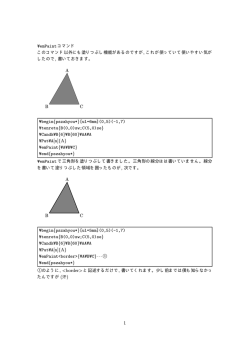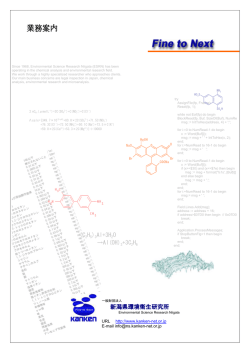
第4回講義資料
字句解析と構文解析
コンパイラ理論 4
構文解析 導入
トークンの提供
ソース
プログラム
字句解析
櫻井彰人
トークンの要求
構文解析
記号表
次の「コンパイラ理論5」も
続けて行います
なぜ分けるか?
字句解析を構文解析から分ける理由:
設計が単純になる
効率(速度等)の向上が図れる
可搬性がます
字句解析・構文解析それぞれによいツー
ルが存在する
属性 Attributes
属性は、トークンのもつ情報。変数、定数、
配列、キーワード、演算子、、、
字句解析は、通常、属性は一個しか与え
ない(構文解析で、いくつも追加される)
トークン・字句・パターン
(Tokens, Lexemes, Patterns)
トークンは、キーワード(if, for, long,...)、演算子
(+,*,...)、識別子、定数、文字列、区切り記号を
含む、字句が属すクラスのことをいう
字句は、文字のある列であって、ソースプログラ
ム内で意味をもつ最小の単位
パターンは、(Lexで用いるが)あるトークンの生
成規則
文字列と言語
アルファベット Alphabet – 記号の有限集合 (例:
ASCII, JIS漢字コード, トークの集合)
文字列 String – アルファベット内の記号の有限
列
言語 Language – あるアルファベットから作られ
る文字列の集合
文字列に関する用語: 接頭辞 prefix; 接尾辞
suffix; 部分文字列 substring;
1
構文解析器 パーサー Parser
字句解析器からトークン列を受け取り(通
常は、一時に1トークン)
そのトークン列が、所定の文法で生成可能
かどうかを調べる
もし構文上の誤りがあればそれを報告す
る (可能な限り修復する)
エラーの取り扱い
エラーは、明確かつ正確に報告する
実はこれが難しい
現象と原因との「距離」が離れている
特に、抽象度のレベルが違う
できるだけ回復する
そこで止まらない、先へ進む
しかし、エラー回復が下手だと、エラーの山が築
かれる
コンパイラ・コンパイラの目的
コンパイラ・コンパイラ: 言語仕様からその言語
のコンパイラを作るコンパイラ、ということは、
「コンパイラ記述用の言語を用いて書いたプログラム」
(コンパイラに決まっている)をコンパイルするプログラ
ム。
なぜこんなややこしいことを考えたのか?
コンパイラを作るのは大変な作業
コンパイラを書くための言語があったらいいなあ
誤り
字句の誤り lexical errors (例: 綴り誤り)
構文の誤り syntax errors (例: 括弧が対応しな
い、セミコロン忘れ)
意味の誤り semantic errors (例: 型誤り)
論理的な誤り logical errors (例: 無限ループ)
エラー回復
パニックモード panic mode: 最近のトークンに対
応するトークンがでてくるまでトークンを読み捨て
る
実は、これができるのは、文脈自由文法の性質による
句 phrase レベルの回復: 非終端記号を読替えて、
構文解析が継続できるようにする
エラーの生成: 文法に、予想されるエラーを生成
するような文法規則を追加する
全体的な変換: 複雑なアルゴリズムで、コスト最
小の変更で、構文解析可能なコードに変換する
コンパイラ
ソースプログラムを解析して、オブジェクト
コードを生成する
ソースプログ
ラム
コンパイラ
オブジェクトコ
ード
FORTRAN I のコンパイラ開発に何年かかったと思う?
エラーメッセ
ージ
2
コンパイラ・コンパイラ
コンパイラ・コンパイラ
コンパイラ・コンパイラ: コンパイラのソースコードを解
析して、コンパイラのオブジェクトコードを生成する
当然、コンパイラのソースコードを各言語は、普通のプ
ログラムのソースコードを書く言語とは異なる。コンパ
イラ専用!!
コンパイラ: ソースプログラムを解析して、オブジェクト
コードを生成する
コンパイラ・コンパイラ: コンパイラのソースコードを解
析して、コンパイラのオブジェクトコードを生成する
ソースプログ
ラム
コンパイラの
ソースプログ
ラム
コンパイラ
コンパイラ
コンパイラの
オブジェクト
コード
エラーメッセ
ージ
リンカー
ローダー
ソースプログ
ラム
オブジェクト
コード
コンパイラの
ソースプログ
ラム
エラーメッセ
ージ
コンパイルのフェーズ
コンパイラ
コンパイラ
エラーメッセ
ージ
コンパイラの
オブジェクト
コード
オブジェクト
コード
エラーメッセ
ージ
コンパイラコンパイラ
コンパイルのフェーズ(おおまか):
字句解析 lexical analysis
構文解析 syntax analysis
意味解析 semantic analysis
最適化 optimization
コード生成 code generation
字句の規則
構文規則
コンパイラ
コンパイラ
意味規則
Yacc プログラムの例
1.
2.
3.
プログラム 2.1
1.
2.
/* プログラム2.1(21ページ) */
/* Yaccで記述した式の定義 */
3.
%%
4.
5.
6.
7.
input
expr
term
factor
8.
%%
:
:
:
:
expr '¥n' ;
expr '+' term | expr '-' term | term ;
term '*' factor | term '/' factor | factor ;
'i' | '(' expr ')' ;
9. yylex()
10. {
11.
return getchar();
12. }
4.
5.
6.
7.
8.
9.
字句解析器
--------パーザー
--------コード生成器
/* プログラム2.1(21ページ) に num digit を追加 */
/* Yaccで記述した式の定義 */
コメント
%%
構文規則の記述が始まることを示す
非終端記号 input を定義する構文規則. 入力データ ( input ) は, 非終端記号 expr によって規定さ
れる文字列のあとに, 改行(¥n)が続いたもの
識別子は, 特別な値をもたせる場合を除いて, 宣言する必要はない
開始記号の宣言をしない限り, 最初の構文規則によって定義する非終端記号が開始記号として扱われる
input : expr '¥n' ; 選択肢の間は, “|” で区切る.‘+’ や ‘-’ は終端記号
実は, yylex が返す値.
Yaccプログラムにとっての入力データはトークンの列である
expr
: expr '+' term | expr '-' term | term ;
term
: term '*' factor | term '/' factor | factor ;
factor : num | '(' expr ')' ;
num
: digit | num digit ;
digit : '0' | '1' | '2' | '3' | '4' | '5' | '6' | '7' | '8' | '9' ;
10. %%
構文規則の定義が終わり, 関数定義が始まることを表す
11. yylex()
getchar() を用いて, 標準入力から1文字を読み込み,その文字コー
12. {
ドをトークンとして返す関数 yylex() の定義
13.
return getchar();
14. }
3
構文解析木の例
再帰下降法(recursive descent)
Pascal のコンパイラで採用
例
再帰下降法が使えるような言語仕様となっている
expr term { ( + | – ) term }
term factor { ( * | / ) factor }
factor id | const | ( expr )
void Expr(void)
次のトークンが一個先読みされている
{
Term();
while (NextSym ==‘+’ || NextSym ==‘-’ ){
int Op = NextSym;
NextSym = yylex() ;
従って、次のトークンを一個先読みする必要がある
Term() ;
printf(" %c " , Op); }
}
Pascal compiler の一部
procedure expression;
var lattr: attr; lop: operator; typind: char; lsize: addrrange;
再帰下降法
expr term { ( + | – ) term }
term factor { ( * | / ) factor }
factor id | const | ( expr )
procedure simpleexpression(fsys: setofsys);
var lattr: attr; lop: operator; signed: boolean;
void Term(void)
{
Factor();
while (NextSym ==‘*’ || NextSym ==‘/’ ){
int Op = NextSym;
NextSym = yylex() ;
Factor() ;
printf(" %c " , Op); }
}
void Factor(void)
{
switch ( NextSym.attribute ) /* いんちき */
{
case id: Id(); break;
case const: Const(); break;
case ‘(‘ :
NextSym = yylex() ;
Expr() ;
if ( NextSym == ‘)’ ) return 0;
else error (“should be right paren”);
}
}
(*[*)
lbrack:
begin insymbol; cstpart := [ ]; varpart := false;
new(lsp,power);
with lsp^ do
begin elset:=nil;size:=setsize;form:=power end;
if sy = rbrack then
begin
with gattr do
begin typtr := lsp; kind := cst end;
insymbol
end
else
begin
repeat expression(fsys + [comma,rbrack]);
if gattr.typtr <> nil then
if gattr.typtr^.form <> scalar then
begin error(136); gattr.typtr := nil end
else
if comptypes(lsp^.elset,gattr.typtr) then
begin
if gattr.kind = cst then
cstpart := cstpart+[gattr.cval.ival]
else
begin load; gen0(23(*sgs*));
if varpart then gen0(28(*uni*))
else varpart := true
end;
lsp^.elset := gattr.typtr;
gattr.typtr := lsp
end
else error(137);
test := sy <> comma;
if not test then insymbol
until test;
if sy = rbrack then insymbol else error(12)
end;
if varpart then
begin
if cstpart <> [ ] then
begin new(lvp,pset); lvp^.pval := cstpart;
lvp^.cclass := pset;
if cstptrix = cstoccmax then error(254)
else
begin cstptrix := cstptrix + 1;
cstptr[cstptrix] := lvp;
gen2(51(*ldc*),5,cstptrix);
gen0(28(*uni*)); gattr.kind := expr
end
end
end
else
begin new(lvp,pset); lvp^.pval := cstpart;
lvp^.cclass := pset;
gattr.cval.valp := lvp
end
end
end (*case*) ;
if not (sy in fsys) then
begin error(6); skip(fsys + facbegsys) end
end (*while*)
end (*factor*) ;
begin (*term*)
procedure term(fsys: setofsys);
var lattr: attr; lop: operator;
procedure factor(fsys: setofsys);
var lcp: ctp; lvp: csp; varpart: boolean;
cstpart: set of 0..58; lsp: stp;
begin
if not (sy in facbegsys) then
begin error(58); skip(fsys + facbegsys);
gattr.typtr := nil
end;
while sy in facbegsys do
begin
case sy of
(*id*) ident:
begin searchid([konst,vars,field,func],lcp);
insymbol;
if lcp^.klass = func then
begin call(fsys,lcp); gattr.kind := expr end
else
if lcp^.klass = konst then
with gattr, lcp^ do
begin typtr := idtype; kind := cst;
cval := values
end
else
begin selector(fsys,lcp);
if gattr.typtr<>nil then(*elim.subr.types to*)
with gattr,typtr^ do(*simplify later tests*)
if form = subrange then
typtr := rangetype
end
end;
(*cst*) intconst:
begin
with gattr do
begin typtr := intptr; kind := cst;
cval := val
end;
insymbol
end;
realconst:
begin
with gattr do
begin typtr := realptr; kind := cst;
cval := val
end;
insymbol
end;
stringconst:
begin
with gattr do
begin
if lgth = 1 then typtr := charptr
else
begin new(lsp,arrays);
with lsp^ do
begin aeltype := charptr; form:=arrays;
inxtype := nil; size := lgth*charsize
end;
typtr := lsp
end;
kind := cst; cval := val
end;
insymbol
end;
(*(*)
lparent:
begin insymbol; expression(fsys + [rparent]);
if sy = rparent then insymbol else error(4)
end;
(*not*) notsy:
begin insymbol; factor(fsys);
load; gen0(19(*not*));
if gattr.typtr <> nil then
if gattr.typtr <> boolptr then
begin error(135); gattr.typtr := nil end;
end;
左再帰と右再帰
左再帰: X | X
右再帰: Y | Y
左再帰: 再帰下降法では無限ループになる
右再帰: 上昇法では、スタックが深くなる
4
LRとLL
最左導出と最右導出
leftmost and rightmost derivation
文法 G = ({S, A, B, C}, {a, b, c}, S, P)
ただし P = {SABC, AaA, A, BbB, B, CcC, C}.
展開(導出)中に、展開すべき非終端記号が複数個ある。その選び
方で、導出過程が異なる
SABCaABCaABcCaBcCabBcCabBcabbBcabbc
最も左の変数を展開すると
SABCaABCaBCabBCabbBCabbCabbcCabbc
最も右の変数を展開すると
SABCABcCABcAbBcAbbBcAbbcaAbbcabbc
Yacc は LR構文解析
Left to right Rightmost derivation
再帰下降は LL構文解析
Left to right Leftmost derivation
一般には、展開する変数の選び方で、結果は大きく異なる
しかし、(曖昧でない)文脈自由文法では、導出結果は同じ。
S
S
A
B
C
A
B
C
a A
b B
c C
a A
b B
c C
b B
最左導出
(leftmost derivation)
b B
最右導出
(rightmost derivation)
5
© Copyright 2026


